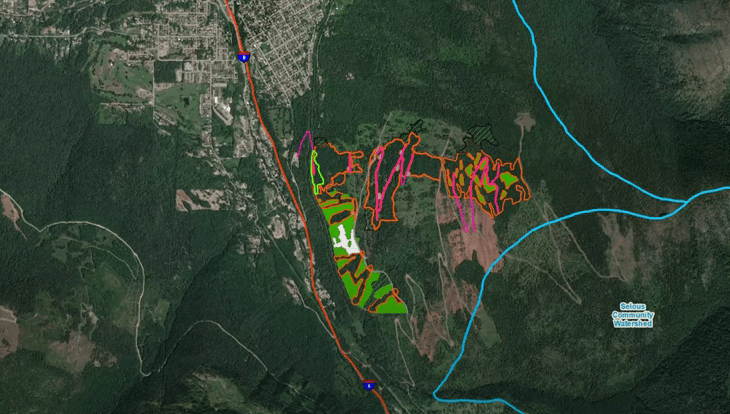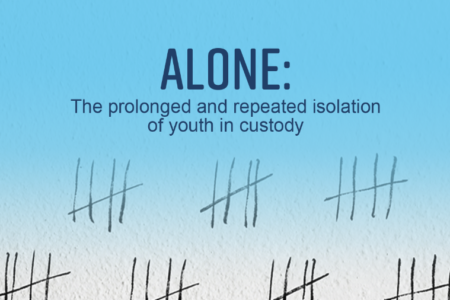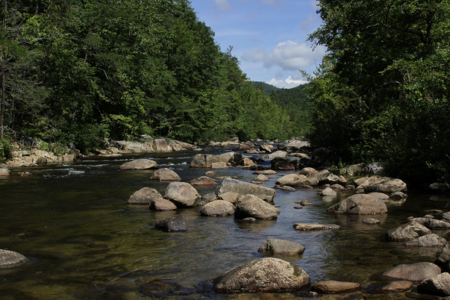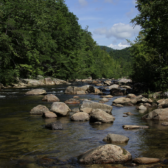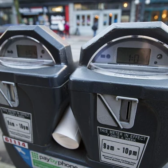Proposal for temporary logging road above city cemetery met with concern
The possibility of constructing a forestry road through beloved piece of forest has galvanized several community members to petition the forestry company to reconsider.
Several Nelsonites and people living outside of the city have been asking the Thrums-based Kalesnikoff Lumber Ltd. to reconsider the construction of a “lower road” in the vicinity of the cemetery trails since it was announced earlier this year selective logging would begin in the area.
Residents of the forest interface, Ann and Denis Coen, begged Kalesnikoff in a letter to not let the logging road happen through the area above the cemetery.
“It is such a beautiful spot, so close to our lovely city … it feels criminal to ruin it,” they wrote in an email letter.
The Coens were in favor of thinning the forest to mitigate the forest fire danger — the forests around the city have been repeatedly earmarked as a high wildfire risk — but building the proposed road was not the way to do it, they felt.
A logging road would “destroy” a network of trails — used extensively by hundreds of people daily for dog walking, hiking, day care outings, cycling and trail running —
“There is an existing road that passes under the second trestle and runs into the proposed cut blocks,” they wrote. “Any reason this could not be utilized?”
But the road access is not a done deal. Gerald Cordeiro, Kalesnikoff forest development manager, said the lower road in the vicinity of the cemetery trails is not a certainty.
“We understand the value of this trail system to the community and do not take lightly a proposal to construct a new road in the area,” he said in an email to the Coens and others. “It has been proposed as a temporary additional access route that would benefit the wildfire risk reduction work being undertaken in the following ways:
“• It would enhance worker safety for those completing all phases of work in the area. This includes the cable harvest operation, post-harvest fuel treatments by the RDCK, and setup for the Selous in Bloom agroforestry initiative; and
“• Having a reliable and gated access road into this area relieves the requirement for alternate measures to protect worker safety such as the likely need for construction of a heli-pad as part of an emergency egress plan, while ensuring unauthorized traffic does not enter.”
Cordeiro went on to write that the road would allow workers and equipment to access the lower portion of the project area, “where gentler terrain permits some ground-based tree removal.”
According to Kalesnikoff the upper slopes of the forest are too steep so an overhead cable harvest system would be used to harvest trees.
“The cable system reduces our ability to conduct single-tree selection harvest, which in this case is intended to retain as many of the larger fire-resilient trees as possible on the hillside,” he wrote.
The lower area accessibility would open up recreational opportunities up higher, Cordeiro explained, with the re-opening of an old mining trail above the rail grade.
“This trail would facilitate selective harvest operations as well as post-harvest fuel treatments, and additionally serve as a new recreation opportunity once the work is complete,” he wrote. “The ability for ground-based equipment to access the area also serves to facilitate the removal of deadfall and smaller broken pieces that would otherwise be uneconomical to deliver to the local pulp mill.”
Lower road benefits
The lower road access would be used as a staging area for post-harvest fuel treatments, noted Cordeiro.
Treatments include removing accumulations from edges of the treatment area, piling small accumulations within the treatment area, pulling fuel away from the retained trees, pruning lower branches on retained trees, and the use of prescribed burns to remove the fuel accumulations.
The Forest Enhancement Society of British Columbia is footing the bill for the work, “and the intent is to achieve the highest level of quality with the available funds.”
“The lower access road significantly increases the ability of the RDCK to complete this work in a safe and efficient manner,” Cordeiro wrote in his email.
“Without equipment access to the lower slopes the task becomes significantly more complex and costly.”
Area to become pilot project
A greater benefit is afoot in the proposed forest road above the city than opening a trail and removing dangerous wildfire fuels.
The road would allow for the delivery and installation of fencing and supplies for the Selous in Bloom agroforestry project, a project which Cordeiro presented a glimpse of to Nelson city council last year.
“This initiative is a pilot project to explore the integration of agricultural elements into interface forests to reduce wildfire behaviour, enhance local food security, and engage people with nature, hopefully proving to be a viable method to help protect our communities while providing a number of local benefits,” he said.
Cordeiro said research and education programs are intended to be developed around the project to help “gain the maximum value.”
Fencing is needed to mitigate wildlife interaction with this small pilot project area, but the area will still be accessible to the public at all times, with unlocked gates that permit people to enter and exit at will.
More information about Selous in Bloom can be found in the video at the following link: https://www.youtube.com/watch?v=2wXQ9A0sVwU
Road building 101
If it was constructed the lower roadway would meet “minimum required specification” and with the minimum clearing width to accommodate the project requirements, then to decommission the road entirely upon completion of the works.
Cordeiro wrote that the road surface would be reduced to a width much too narrow for motorized traffic and become a new rec trail at that point.
“Disturbed ground along the right of way would be re-planted with trees and seeded with a suitable non-invasive grass mixture,” he said.
The Coens wondered why the area would be needed at all, however.
“We are wondering if there has been an environmental assessment done on the impact of this road” We are wondering if the general public had any say in the matter?” they added in their email.
Discussions are currently underway with the various other administrations and agencies involved in the project to consider financial costs against the merits of the lower access road, and the sentiment of public opinion is heavily considered, Cordeiro said in his email.
“A final decision to proceed with a road in this location will not be at the sole discretion of Kalesnikoff, but rather as a part of a collaborative process involving various levels of government, local experts and, of course, public opinion,” he wrote.
Cordeiro said it was possible to not build the lower road and still carry out the work, but a staging area in an area high above the rail grade would reduce the effectiveness of the treatments (and be of a lower standard) and would certainly increase cost.
“Because the post-harvest works are being funded through provincial programs we must consider all feasible options to enable the best results within the specified budget,” he wrote.
“The premise of this proposal is based upon a short-term disruption to only some sections of the many trails in the area, with considerable long-term benefits to the community in terms of wildfire resilience.”



